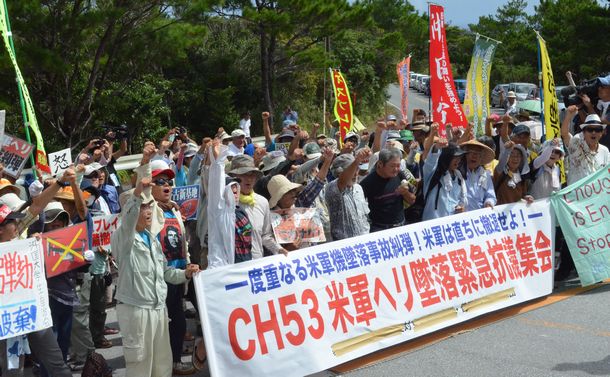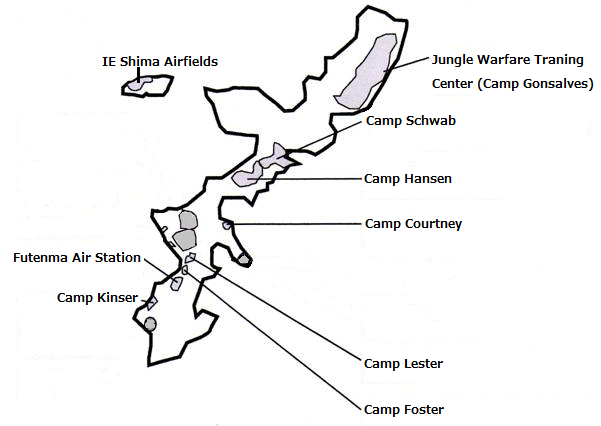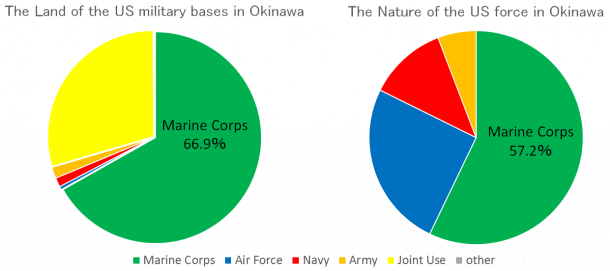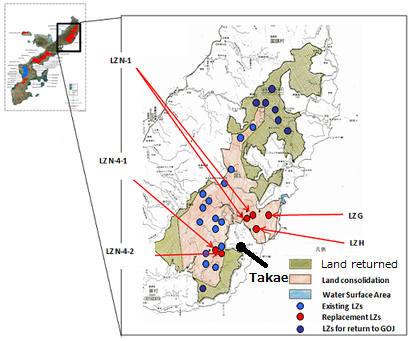2018年08月10日
 Protest following the crash landing of a U.S. military helicopter near Camp Gonsalves in Okinawa, Oct. 15 2017
Protest following the crash landing of a U.S. military helicopter near Camp Gonsalves in Okinawa, Oct. 15 2017“The Targeted Village (Hyoteki no mura)” is a TV documentary produced by Ryukyu Asahi Broadcasting in 2012, and re-released as a documentary film in 2013. The documentary won a lot of prizes such as the Galaxy Prize (TV section).
The interviewees of the documentary are the residents living at Takae in Higashi Village, Okinawa. They resisted the construction of U.S. military landing zones that threatened to encircle their town, then the fifteen residents including a 7-year-old girl, were indicted by the Japanese government for their obstruction. Nevertheless, after receiving news that the MV-22 Osprey aircraft would use the landing sites, the residents continued their legal battle for about three and a half years and protests in front of the construction site. The Osprey is a transport aircraft, known for many accidents during its development phase, and criticism that it is too dangerous to deploy.
The most famous issue of Okinawa base problems has been Futenma relocation since the Special Action Committee on Okinawa (SACO) agreement between the U.S. and Japanese governments in 1996. The SACO was established in November 1995 to reduce the burden of U.S. military bases on the people of Okinawa and strengthen the U.S.-Japan alliance with the rape incident by three U.S. marines which victim was a 12-year-old girl in the summer of 1995 as a start.

Apparent from this map showing locations of the U.S. Marine Corps Facilities in Okinawa, there has been a vast area of Marine Corps facilities including the Futenma Air Station, which cover about 67% of the U.S. military bases in Okinawa.

Therefore, not only the Futenma Air Station but also some of parts of the Jungle Warfare Training Center (Camp Gonsalves) were pledged to be returned to the Government of Japan on the SACO agreement under the condition of the construction of alternative facilities at Japanese expense.

Takae, the north side of Higashi Village, is a small town of only 150 people, separated from the rest of the village by Camp Gonsalves. When Takae’s residents heard of the construction of new landing zones (LZs) at Camp Gonsalves that would surround them in 1999, they adopted a resolution against the construction. Against their will, the U.S. and Japanese governments agreed with the construction of six sites of landing zones at Takae in 2006, and the mayor of Higashi Village accepting the plans in 2007. The residents of Higashi Village were divided not just by the U.S. military base, but by politics.
In addition, the Japanese government charged the fifteen residents of Takae engaged in a sit-in protest against the landing zones at the Camp Gonsalves gate, and the Naha District Court issued an executive order that one of the charged residents could not block the passage of government officials. The Supreme Court of Japan upheld the order in June 2014. Furthermore, the construction of two landing zones was completed, and the U.S. Marine Corps began using them in February 2015. These events caused heavy damage to the unity of the resisting residents. When construction of the remaining landing zones was begun in July 2016, a reduced number of residents came out in protest. The residents of Takae were also divided. Instead, about from 100 to 200 supporters coming inside and outside Okinawa added sit-in with about ten residents of Takae, but finally the construction of all the landing zones was completed in the end of December 2016.
Why does relocation of the U.S. military bases raise anti-base movements by the residents around the relocation sites in Japan?
有料会員の方はログインページに進み、朝日新聞デジタルのIDとパスワードでログインしてください
一部の記事は有料会員以外の方もログインせずに全文を閲覧できます。
ご利用方法はアーカイブトップでご確認ください
朝日新聞デジタルの言論サイトRe:Ron(リロン)もご覧ください